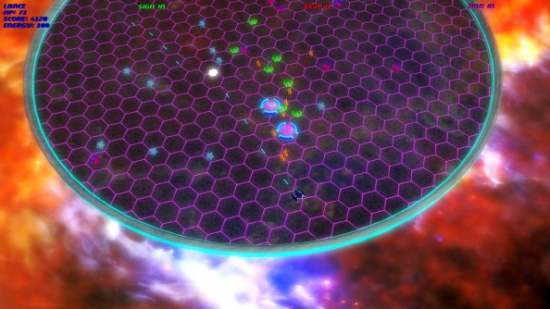Oh Saturday, inevitable Saturday. As another arrives, so too does another Spotlight on Greenlight, where I cherry-pick five of the best and most interesting projects on Steam’s indie service, and where Jeremy tries to get me to include something that I don’t want to. No, Jeremy, I’m not going to link to that strange gun-building game. That’s a little too fetishistic for a Saturday afternoon.
Oh, damn.
Oh God, even looking at a game like this immediately makes me stressed. All those enemies, all those bullets. But at the same time, I’m also soothed. Look at all that colour, all that neon. What a strange conflict of emotions I find myself subject to.
I
would likely be terrible at Geo Bots if I played it, but I was a big fan
of one of Geometry Wars, one of the games from which it takes inspiration. I just love
the aesthetic because I’m a sucker for neon in games.
Parallax
Parallax
is a perfect example of why we should be excited about indie gaming.
It’s both ingenious and idiosyncratic, a first-person puzzle platformer
set in a world that’s entirely black and white, where the challenge is
not simply to get to the right part of the level, but also to be there
at the correct moment and “in the right dimension.” I would certainly be
terrible at this, too, but I’m nevertheless impressed by how
distinctive and remarkable it’s looking. This is definitely one to watch.
Die Crypter
Here’s
even more neon for you, colouring the Tron-like world of this top-down
stealth puzzler. Die Crypter has you sneaking your way through maze-like
environments that are glowing with gorgeous colour as you try to avoid
sentry robots who, if they detect you, will mercilessly chase you down.
What I like most about this game is the patrol routes of the enemies,
which look to be random than predetermined. Sure, that’s a fairly minor
detail, but for me, a fan of stealth games, predictable patrol patterns
are immersion killers. Nobody performs the same short walk over and over
again, timed to perfection. Not unless they’re going nuts, anyway.
Bridge It
Watch the video first, then come back to read the rest of this, okay?
Right,
admit it, you liked it when that boat rammed its way through the bridge
too, didn’t you? I’m not sure if the appeal of a game like Bridge It
comes from the slow and methodical process of construction, or if it
just comes from being able to watch your creations collapse when
everything goes wrong. Bridge-building games have been around for years
and though it’s a genre that lacks mainstream appeal, they are oddly
fascinating things and, if anything, offer painful lessons for would-be
engineers.
BattleBall
I just had to include this. We mention retro gaming a lot when we’re talking
about what indie developers are up to. We’re always talking about how a
platformer has 8-bit aesthetics, about tightly-designed top-down
shooters that take inspiration from the games of yesteryear, about old
school adventure games, but this is a little bit special. BattleBall is arguably the most retro of them all and I’m delighted to see how it’s dragging a classic game into the 21st century. That game is Pong.
Yes,
at its core, this is a game about bouncing a ball back at your
opponent, but there’s a hell of lot more in the mix now. BattleBall has
dynamic arenas which are constantly reshaping themselves, new game modes
where the ball becomes a weapon or a time bomb, even power-ups and
weapons. It takes a tired and tedious game mechanic that we’d long
forgotten about and drives a syringe loaded with innovation into its
neck.
